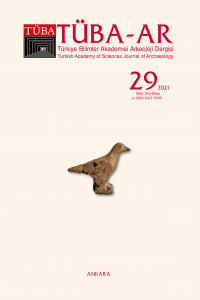SMYRNA / İZMİR KAZILARI KEMİK BULUNTULARI
Smyrna İzmir Kazıları, 2007 yılından itibaren Smyrna Agora, Kadifekale ve Basmane mevkilerinde sürdürülmektedir. Bu mevkilerdeki çalışmalar sonucu ele geçen kemik eserlerin büyük bir çoğunluğu, bu çalışma içerisinde değerlendirilmiştir. Seçilmiş parçalardan oluşan bu eserlere bakıldığında, MS.1. yüzyıldan- Osmanlı Dönemine kadar uzanan kronoloji içerisinde temsili örnekleri görmek mümkündür. Roma Dönemine ait saç ve dikiş iğneleri, oyun taşları ve markaları, Bizans Dönemine ait tipik kemik ağırşaklar ve Osmanlı Dönemine ait çok sayıdaki kemik eser, bu buluntu grubunu oluşturan ağırlıklı eserlerdir. Çoğu antik kentte benzerlerine sıklıkla rastlanılan bu eserlerin yanı sıra, çok sayıda ve düzgün bir şekilde kesilmiş kemikler, yarı işlenmiş halde bulunan kemik buluntular, Smyrna Agorası'nda olası bir kemik işliğinin varlığı ile ilgili araştırmaları da beraberinde getirmiştir.
Anahtar Kelimeler:
Smyrna, Agora Kazılan, kemik buluntular, arkeoloji.
BONE FINDINGS FROM SMYRNA / İZMİR EXCAVATIONS
Smyrna Excavations has been conducted since 2007 in the Agora of Smyrna, Kadifekale and Basmane. Most of the bone findings found in these excavations have been examined in this study. Findings from a wide range, l.century B.C. to Ottoman Period, are represented in this study of selected findings. Majority of the findings consists of bone pins and needles, gaming pieces and counters from Roman Period, typical bone spindle whorls from Byzantium Period and many bone findings from the Ottoman Period. Apart from these common findings found in every settlement other finds such as purposefully cut bones and semi-worked bone findings has brought further study into a possible bone workshop in the Agora of Smyrna
Keywords:
Smyrna, Agora Excavations, bone findings, archaeology,
___
- Arslan, M / Metin, M. 2013. Juliopolis, Kayıp Kent Juliopolis. İstanbul.
- Baù, A. 2004. La tabletterie gallo-romaine à Martigny/Forum Claudii Vallensium. Lausanne.
- Baykan, D. 2012. Allianoi Tıp Aletleri, SOA 2, Studia ad Orientem Antiquum, Türk Eskiçağ Bilimleri Enstitüsü Yayınları, İstanbul.
- Daim, F/ Ladstàtter, S. 2011. Bizans Döneminde Ephesos, İstanbul.
- Davidson, G.R. 1952. The Minor Objects, Corinth Vol. XII , Princeton, New Jersey.
- Gassner, V. 1997. Das Südtor der Tetragonos-Agora. Keramik und Harrison, R.M. 1986.
- Excavations at Saraçhane in İstanbul. Vol. l. The Excavations, Structures, Architectural Decoration, Coins, Bones,and Molluscs. Princeton, New Jersey.
- Krinzinger, F. 2010. Hanghaus 2. Wohneinheiten 1 und 2. Baubefund, Auss¬ tattung, Funde, Forschungen in Ephesos Vlll / 8, Wien.
- Lambrick, G/Woods, H. 1976. Excavations on the Second Site of the Dominican Priory, Oxford.
- MacGregor, A. 1976. Finds from a Roman Sewer System and an Adjacent Building in Church Street, The Archaeology of York: The Small Finds 17/1, (Ed. P.V. Addyman) First published by Council for British Archaeology. Wisconsin - Ma¬ dison University, (Digital edition produced by Lesley Collett, 2011)
- MacGregor, A. 1985 Bone, Antler, lvory and Horn: Technology of Skeletal Materials Since the Roman Period. London.
- Selvi-Bener, S. 2013. Antikçağda Oyun ve Oyuncaklar, İstanbul.
- Stocks, R. 2013. Miscellaneous, Organics and Non-structural Metals Re¬ port, Darling Quarter, Darling Harbour, report for Casey & Lowe Pty Ltd, June 2013. Vol 3, Section 8.2.
- Şimşek, C. 2011. Laodikeia Nekropolü (2004-2010 yılları), 1.1-1.2. (Ege Yayınları) İstanbul.
- Waelkens-M. / Poblome, J. 2011. Sagalassos City of Dreams, (Ed. Patrick De Rynck). Provinciaal Gallo-Romeins Museum, Tongeren, Pu
- ISSN: 1301-8566
- Başlangıç: 1998
- Yayıncı: Türkiye Bilimler Akademisi
Sayıdaki Diğer Makaleler
SİNOP BALATLAR KİLİSESİ KAZISI SIRLI BİZANS SERAMİK BULUNTULARININ ÖN DEĞERLENDİRMESİ
KUZEY LYDIA'DAKİ THYATEIRA'NIN ERKEN DÖNEM YERLEŞİMİ: 'HASTANE HÖYÜĞÜ' KAZISI
TARİHİ YARIMADA'NIN BAZI BİLİNMEYEN BİZANS DÖNEMİ SARNIÇLARI
"GÖBEKLİ TEPE" ÖRNEĞİNDE İNSANİ EŞGÜDÜMLÜ EYLEM, DİN VE İLETİŞİM
FATSA CINGIRT KAYASI 2012-2014 SEZONU KAZILARINDAN ELE GEÇEN AĞIRLIKLAR ÜZERİNE DEĞERLENDİRMELER
SMYRNA / İZMİR KAZILARI KEMİK BULUNTULARI
Akın ERSOY, Gülten Çelik ERSOY
TARİHİ VERİLER VE ARKEOLOJİK BULGULARLA KEYKUBADİYE SARAYI
